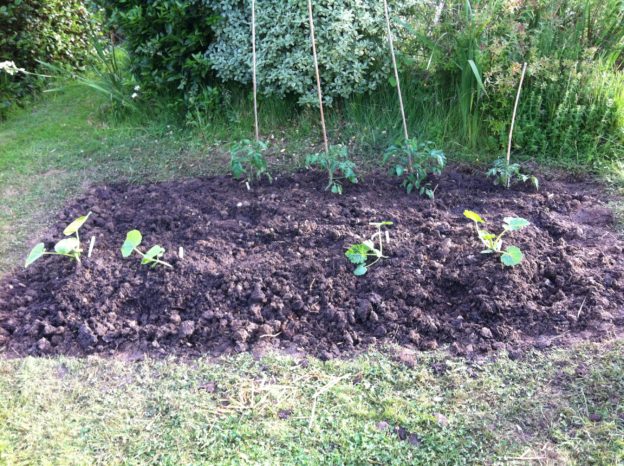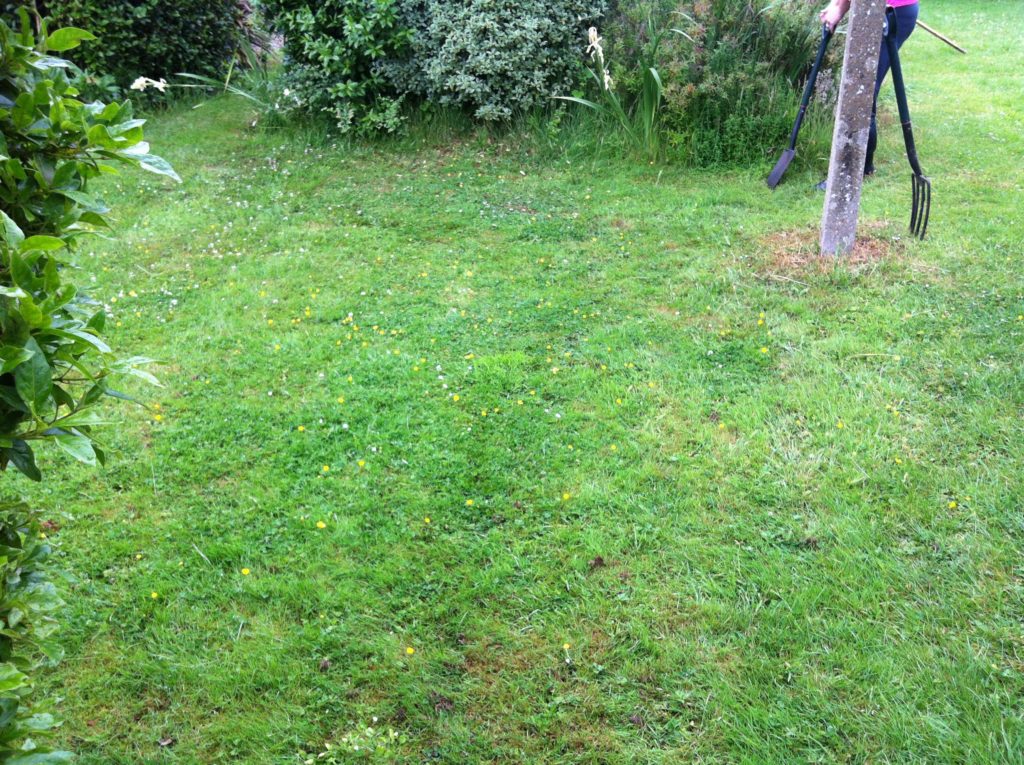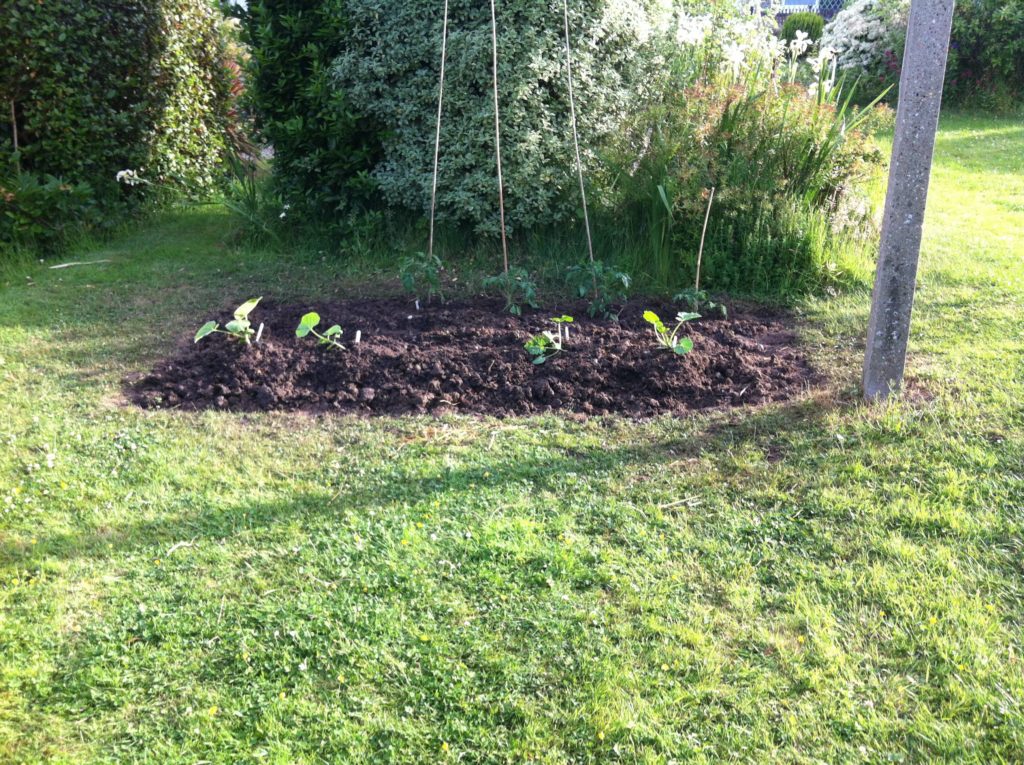It’s official: we now have a pumpkin patch! Well, sort of, there are currently no pumpkin plants in it, but there are some squash plants. I just think ‘pumpkin patch’ has more of a ring to it than ‘squash patch’. We were running quite late on Saturday as I ended up helping my dad at the allotment into the early afternoon, and in the end Liz and I didn’t get to work on the garden until the evening. But we made very good use of the three hours or so we spent out there.
We removed the turf from a rectangular area of the patch we were clearing. We only cleared about half of the area we ultimately plan to, but some of our plants were really getting too big for pots, so we decided to tackle the area in two phases.
We removed the turf by cutting lines about two inches (5cm) deep with the tip of a spade, about one and a half spade’s width apart across the area we planned to clear. This left us with several defined strips of turf to remove. Then strip by strip we dug the spade into the end of the strip of turf, and pushed it about an inch and half deep just under the roots of the grass. Then we hacked away with the spade just under the roots for the length of the strip, rolling the turf up as we went along. By the time we were at the end of the row we had what looked like a giant turf Swiss roll. It was quite time consuming, but we got there in the end.
Once all of the turf was removed we set about turning the soil. This wasn’t easy, as it was bone dry and we struggled to get a fork in. A neighbour offered us the use of her fork, which was much sharper than ours, and could just about break through. By the time we had turned the soil we were losing daylight, so we packed up for the night, very pleased with what we had achieved.
The next evening we were back outside again and working on the patch. A neighbour kindly donated us three sacks off well-rotted, straw-free horse manure, which she had collected from a local stable. We spread these evenly over the area we had turned the night before, and forked it all in. Or, to be more precise, Liz forked it in whilst our neighbour and I went off to collect some more manure. The previous tenants had kept chickens at the bottom of the garden, and where their coup had been stands a mound which largely consists of rotted chicken manure. So we forked this into our wheelbarrow, and spread this over the patch too. Before going back for a second barrow of chicken manure, and spreading that over. So the patch should now be very well fertilized. We then ran a hose over it for a while to rehydrate the very dry soil.
The patch now prepared, we set about planting. We decided to run a row of cordon type tomatoes along the back of the patch, as this is the sunniest spot of the garden that we are planting directly into. We were given the plants by a neighbour who had a surplus. The varieties are ‘Big Daddy’ and ‘Brandywine’. I’m looking forward to trying both, but I am particularly looking forward to the Brandywines, as it is a variety I’ve read good things about and has been on my list of varieties to try for years.
Then we moved onto the squash family of plants (cucurbits). We choose which to plant based on their sizes, the biggest two squashes and the biggest two courgettes that we had in pots on the patio. These were two yellow courgette plants, and the squashes were one each of ‘Turk’s Turban’ and ‘Bon Bon’. I love the idea of growing a Turk’s Turban squash, as they are so recognisable, and so beautiful. We purchased one from a farm shop last year, and it was delicious. But with a squash as colourful as the fruits of this variety, its greatest asset is its looks.
I had never heard of the variety Bon Bon until I saw it in the seed catalogue. The description said that the fruits have a delicious, sweet flavour, and that the plants are prolific fruiters. What’s more it said that they are a semi-bush type plant, making them suitable for the smaller garden. This was its greatest appeal for me, as we hope to grow quite a few varieties of squash, so having some more compact plants in amongst the larger sprawling ones is desirable.
I’m pleased our neighbour was there, as she advised us on spacing. Having never planted squashes out before, I think we’d have been too cautious. The seed packet said to leave about 5 feet (1.5m) between plants, but our neighbour said that they needn’t be so far apart, as we could move them around each other when they sprawl. So we’re relying on her judgement this year, and we planted them where she suggested.
So that is where we’re up to, the pumpkin patch is finally up and running. We have dreamed of growing our own winter squashes for years, but we never had the space. We tried a dwarf variety in large pots last year, but they didn’t fruit. So hopefully this is the year. Years of longingly browsing the seed catalogues has left us with a long list of varieties that we hope to try. Finally the wheels are set in motion and we have our first squash plants in the well fertilized ground. We also have several other varieties that we have long desired to try growing nicely in pots ready for the extension to the pumpkin patch. Now we need some sunshine!




